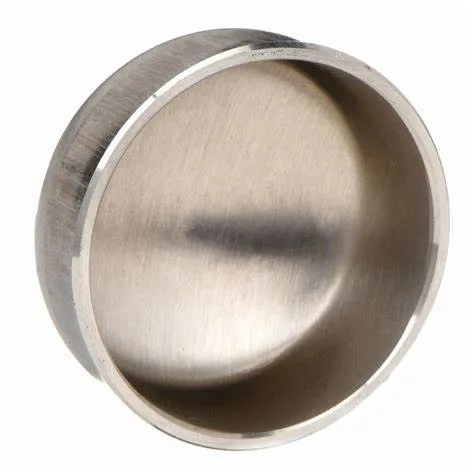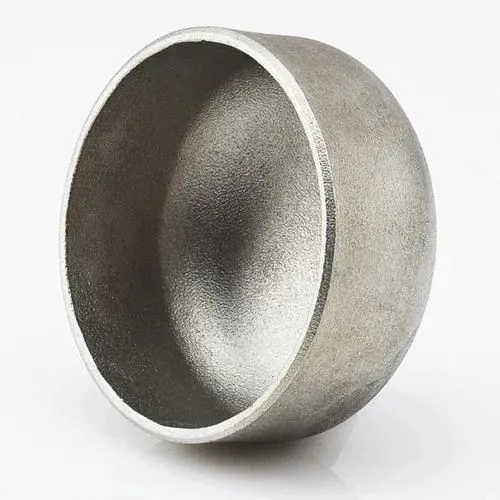JIS B2311 es una norma industrial japonesa que cubre los accesorios de tubería soldados a tope, incluidas las tapas utilizadas en sistemas de tuberías. Las tapas para soldar a tope sirven para cerrar el extremo de una tubería, proporcionando un sello para evitar fugas o contaminación. Aquí hay una introducción a las tapas para soldadura a tope JIS B2311:
- 1. JIS B2311 Standard:
- - La norma JIS B2311 especifica los requisitos para el diseño, dimensiones, materiales, fabricación y prueba de accesorios para soldadura a tope, incluidas tapas, en sistemas de tuberías.
- - La norma garantiza que las tapas producidas de conformidad con las normas JIS cumplan con los estándares de calidad y sean compatibles con otros componentes de tuberías.
- 2. Tapa para soldar a tope:
- - Una tapa para soldadura a tope, según JIS B2311, es un accesorio diseñado para cubrir y sellar el extremo de una tubería de forma segura, ofreciendo protección y manteniendo la integridad del sistema de tuberías.
- - Los tapones se utilizan en situaciones en las que el extremo de la tubería requiere cierre, ya sea de forma permanente o temporal, para evitar fugas, contaminación o para proporcionar un acabado al sistema.
- 3. Material y Construcción:
- - Las tapas para soldadura a tope según las especificaciones JIS B2311 están disponibles en varios materiales, como acero al carbono, acero inoxidable y acero aleado, para cumplir con los diferentes requisitos de aplicación.
- - Estas tapas se fabrican utilizando métodos de construcción estandarizados para garantizar una conexión fuerte y sin fugas cuando se sueldan al extremo de una tubería.
- 4. Aplicación y Beneficios:
- - Los tapones para soldadura a tope encuentran aplicaciones en diversas industrias, incluidas las de petróleo y gas, procesos químicos, plantas de tratamiento de agua y más, donde es necesario tapar de forma segura los extremos de las tuberías.
- - Las tapas brindan protección a los extremos de las tuberías contra elementos ambientales, previenen la contaminación y ayudan a mantener la limpieza e integridad del sistema de tuberías.
- 5. Instalación y Soldadura:
- - Las prácticas de instalación adecuadas, incluida la alineación correcta, la preparación del extremo de la tubería y las técnicas de soldadura, son esenciales al instalar tapas de soldadura a tope para garantizar un sello hermético y a prueba de fugas.
- - La soldadura es un método común para fijar tapas a tuberías, proporcionando un cierre seguro y permanente que puede soportar variaciones de presión, temperatura y flujo de fluido dentro del sistema.
- En resumen, los tapones para soldadura a tope JIS B2311 son componentes cruciales que se utilizan en los sistemas de tuberías para sellar y proteger los extremos de las tuberías de forma segura. Estas tapas cumplen con los requisitos estandarizados para garantizar la calidad, confiabilidad y compatibilidad dentro de aplicaciones industriales donde el cierre y la protección de tuberías son necesarios.
What Is a Butt Welding Cap and How Is It Used in Industrial Piping?
In industrial piping systems, end-of-line sealing and branch closures require robust solutions. A butt welding cap serves as a critical component for terminating pipes securely. By providing a seamless, welded closure, this fitting maintains system integrity, prevents leaks, and supports compliance with industry standards.
What Is a Butt Welding Cap?
A butt welding cap—also called a pipe end cap or buttweld end cap—is a round fitting designed to close off the end of a pipe. It’s manufactured to match the pipe’s outer diameter and schedule, with either a hemispherical or flat face. To install, both the pipe end and cap are beveled to form a V‑groove, enabling full‑penetration, fusion welds. Common materials include carbon steel, stainless steel, nickel alloys, and other engineered grades, chosen to satisfy pressure, temperature, and corrosion‑resistance requirements.
How Is Butt Welding Cap Used in Industrial Piping?
Butt welding caps find application across oil & gas, petrochemical, power generation, water treatment, and general process industries for both permanent and temporary closures. During hydrostatic testing, technicians install caps to seal off sections of piping while monitoring for leaks. In new construction or retrofit projects, caps terminate branch lines, future tie‑in spools, or dead‑end mains until system expansion. Welders prepare each joint by cleaning and beveling surfaces, aligning the cap precisely, and executing a root pass followed by filler passes per the qualified Welding Procedure Specification (WPS). Post‑weld heat treatment and non‑destructive examination (NDE)—such as radiography or ultrasonic testing—verify weld integrity and compliance with ASME B16.9 and related standards. Additionally, temporary caps enable safe isolation during maintenance, allowing for segment testing and dewatering under regulatory protocols.
Benefits and Best Practices
Butt welding caps offer a smooth‑bore transition that minimizes flow disruption and stress concentration. Their full‑penetration welds deliver exceptional structural strength and leak resistance. To optimize performance, engineers should:
Select caps with matching material grades and wall thicknesses
Adhere to proper bevel angles and joint fit‑up tolerances
Follow qualified WPS protocols rigorously
Consider cladding or protective coatings in corrosive environments to extend service life
Regular inspection and thorough documentation ensure long‑term reliability and safe operation under demanding conditions.
Butt welding caps are indispensable components for achieving durable, leak‑proof pipe terminations in a wide range of industrial applications.
Butt Welding Cap FAQs
What is a butt welding cap?
|
What materials are commonly used?
|
What standards govern butt welding caps?
|
How are butt welding caps installed?
|
Where are butt welding caps typically used?
|
What are the advantages of threaded caps?
|
















